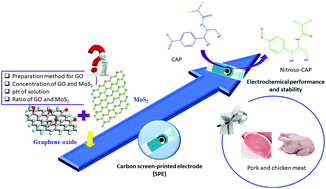Ultrasensitive determination of chloramphenicol in pork and chicken meat samples using a portable electrochemical sensor: effects of 2D nanomaterials on the sensing performance and stability†
Abstract
Functional two-dimensional (2D) structured nanomaterials, such as, graphene oxide (GO) and molybdenum disulfide (MoS2), exhibit many advantages, including large surface areas and excellent electronic/mechanical/catalytic properties, and have shown to be strong candidates for the development of advanced electrochemical sensors for determining a variety of chemical and biological analytes in different samples. In this work, for the first time, we systematically investigated the effects of functional 2D nanomaterials, such as GO nanosheets, MoS2 nanosheets, and their GO–MoS2 hybrid nanostructures, with a special emphasis on synthesis methods (GO-Hummers, GO-CVD, GO-Ultrasound), active surface areas, layer number, defect density, and chemical groups on the surface of GO nanosheets toward electrochemical sensing performance using carbon-based screen-printed electrodes (SPEs) for the determination of chloramphenicol (CAP) antibiotic residues in food samples. Under the same experimental conditions, GO-Hummers with the largest interlayer distance and the lowest defect density showed higher electrochemical performance than GO-CVD and GO-Ultrasound due to a more active surface area. Moreover, the combination of layers-by-layers MoS2 and GO nanosheets could expose more active sites and facilitate the charge-transfer ability, leading to a significantly enhanced electrochemical performance. Based on obtained electrochemical results, we found that the active surface area, layer number and interlayer distance, and defect density were key factors in the CAP electrochemical sensing performance of these 2D nanomaterials. Also, the long-term stability, reproducibility, and applicability of these sensors for the determination of CAP in chicken and pork meat samples were also evaluated. These studies further contribute to a deeper understanding of the effects of 2D nanomaterials on the electrochemical sensing performance of SPE-based portable sensors for the rapid, accurate, and on-site determination of CAP in real samples.



 Please wait while we load your content...
Please wait while we load your content...